Art Fairs
Shanghai’s West Bund Art Fair Attracts Strong International Presence
Several international galleries were doing a fair in mainland China for the first time.
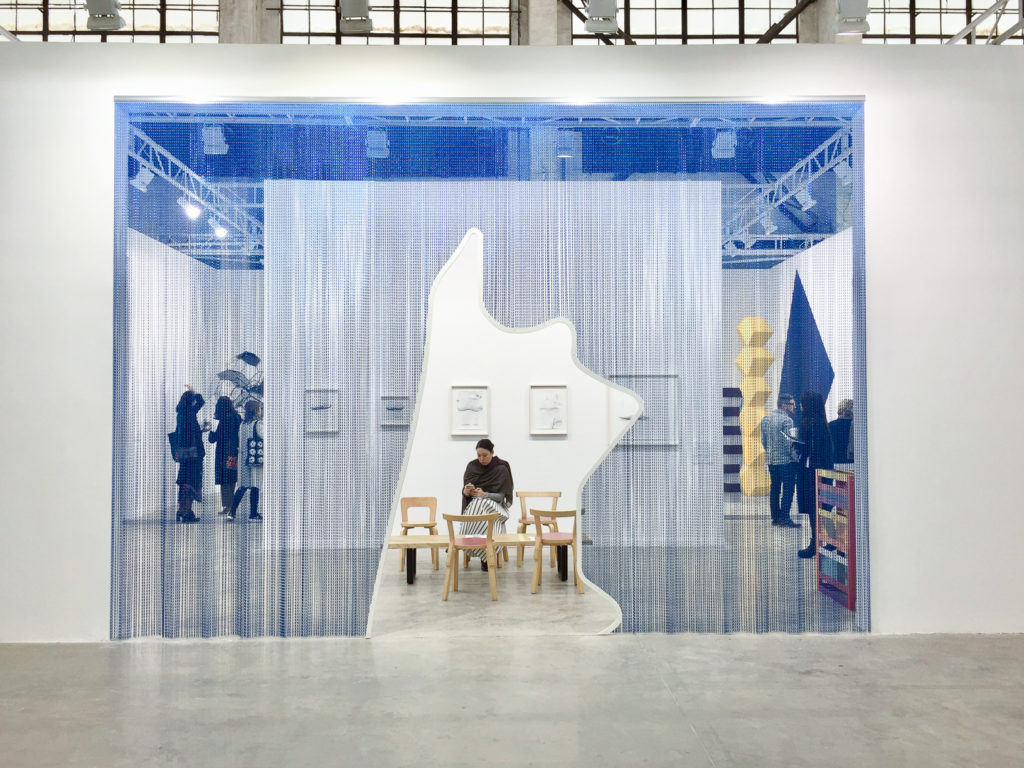
Several international galleries were doing a fair in mainland China for the first time.

Rozalia Jovanovic

The West Bund Art & Design Fair, now in its third edition, is a thoughtfully curated outing in a beautiful space. With 31 galleries both local and international, the number of booths is the same as last year, but this time there are many new faces and the fair has a more global footprint, which was lost on few.
“There are more international galleries coming,” fair director Zhou Tiehai told me during the VIP preview. “It’s the first time we have Zwirner, Tim Taylor, Esther Schipper, Gladstone, and Long March.”
He also noted that this year, a new element of the fair is ArtReview Asia Xiàn Chǎng, a special series of 25 projects both throughout the fair and around the trendy West Bund area, including the train station, curated by the editors of ArtReview Asia.
Unlike the traffic thoroughfares of the mega fairs like Art Basel and Frieze, the aisles at the boutique West Bund on November 8, its preview day, were calm and focused but gradually got more buzzy as the morning wore on. And while sales were slow-going on opening day, for most of the new galleries, their participation was less about sheer numbers and more a matter of having a presence and educating a new audience.
MoMA PS1 director Klaus Biesenbach toured the booths with fellow curator Hans Ulrich Obrist and artist Simon Denny, who was showing work at “Hackspace,” an exhibition at the K11 Art Foundation, which opened that evening. David Zwirner and Emanuel Perrotin were both in their booths chatting up fair-goers and Tiehai, who is also an accomplished artist, was a warm, avuncular presence.
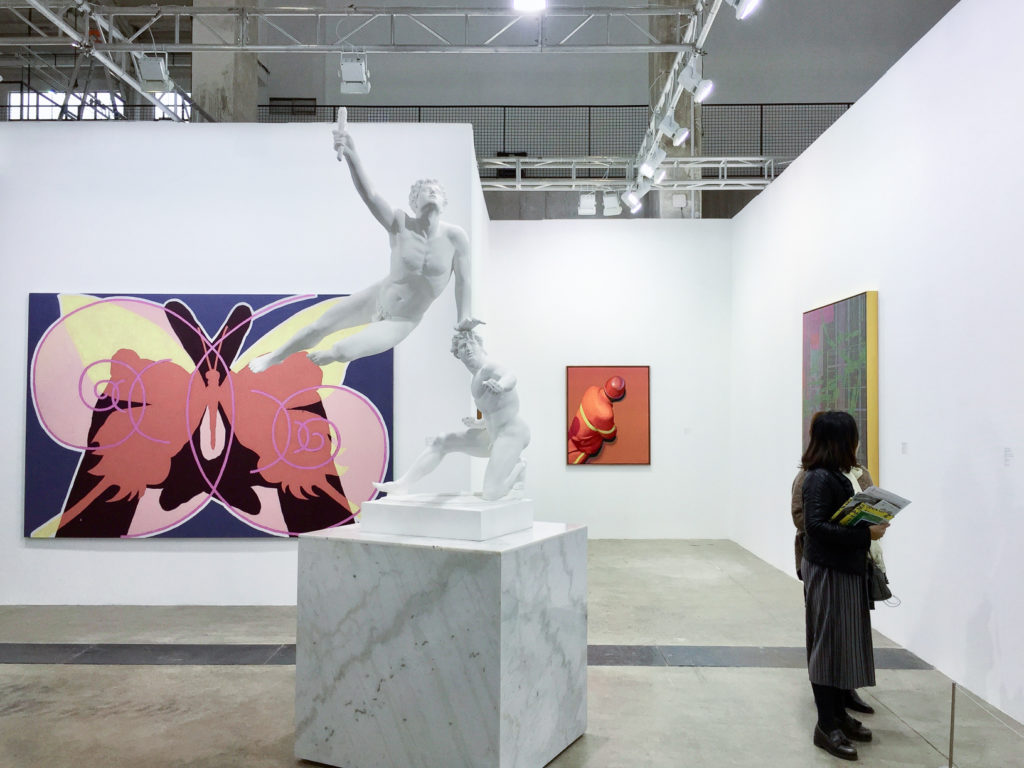
Long March Space. Courtesy of Zhongming.
The galleries brought carefully selected, enticing work, if 2-D for the most part, and often by recognizable names. Beijing-based Long March Space, which was participating in the fair for the first time, had a flamboyant white concrete and marble sculpture at the center of the booth of two nearly life-sized figures balanced in a contrapposto arrangement on a pedestal by perennial favorite Xu Zhen, as well as a large colorful partly-abstract painting of a butterfly by Wu Shanzhuan, in addition to a painting dotted with artificial stainless steel rocks by Zhan Wang.
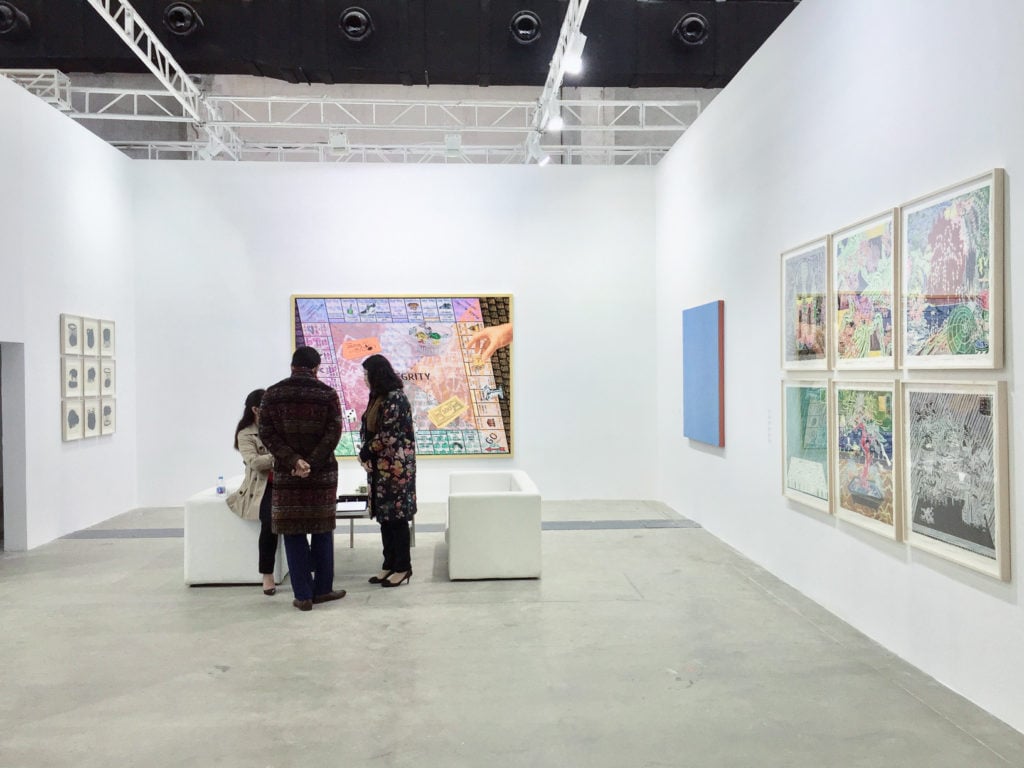
OTA Fine Arts. Courtesy of Zhongming.
The director of Tokyo-and-Singapore-based gallery OTA Fine Arts brought a shiny stainless steel pumpkin sculpture by Yayoi Kusama, who has been showing with the gallery since the 1990s, and displayed it prominently outside the booth. But inside the gallery’s walls were works by lesser-known artists as well as more accessible works, like a series of prints by Masanori Handa, which were selling for $2,500-$3,000—several of which had already sold.
“It’s more of a process,” said Vera Yu of Shanghai’s Bank gallery about selling to collectors at the fair. “You have to educate, and let people study the work.” She said last year they brought work by Marina Abramovic. “She did well because people know her.”
“The first year we sold everything in the booth,” said Leng Lin, the director of Pace Beijing, which brought works by Tara Donovan, teamLab, and James Turrell. “This year, we sold a few things.” The works sold were a painting by Qiu Xiaofei and a large wall work by Kiki Smith, and there was a large flashy light box work by teamLab that was on reserve. All the works in the booth were under $500,000.
The gallery featured colorful sculptures made of shredded plastic bags by Heidi Voet, who is collected by a number of institutions here. “K11 Art Foundation collected some of Voet’s watches,” she said. As for what had sold thus far, there was a large figurative painting of a man by Zheng Haozhong. Works in the booth ranged from 15,000 – 280,000 Chinese yuan ($2,200–42,000), while an installation on the first floor, Avatars of Power by Jin Shan, which included a large, overturned sculpture of a horse on a pedestal, was selling for 800,000 yuan (or roughly $118,000). Yu said that for the local market painting is more popular, but this year there were lots of international collectors as well and that tastes seemed to be shifting from last year.
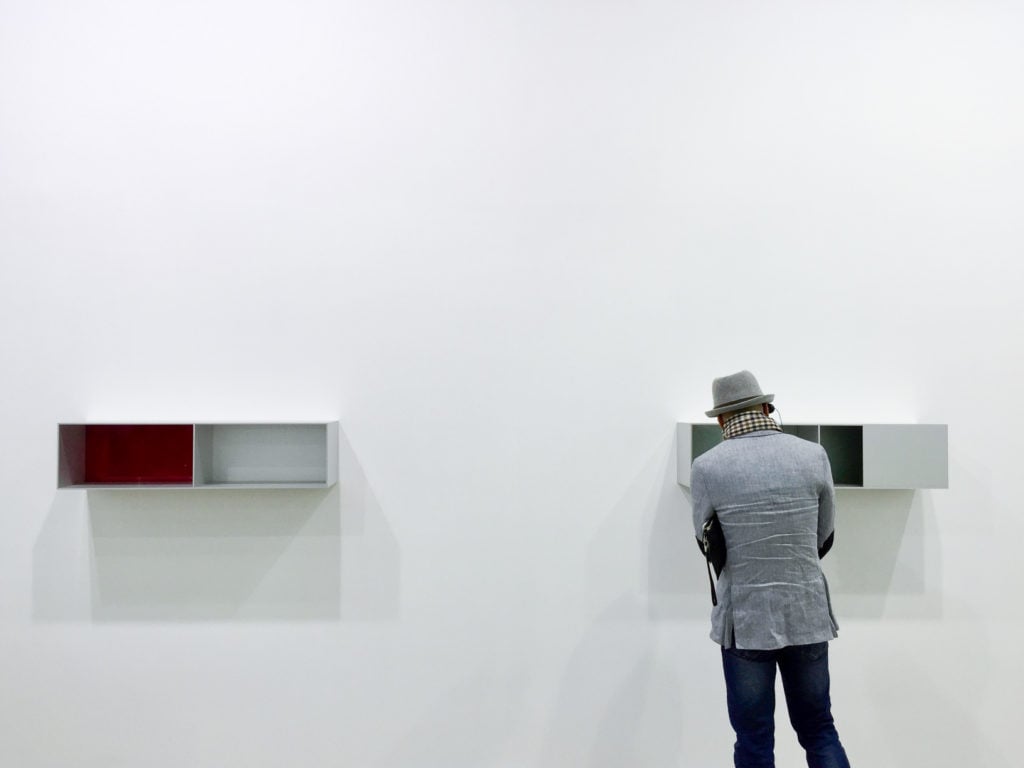
David Zwirner. Courtesy of Zhongming.
For the international galleries, while dealers resisted articulating what, if anything, defined collector taste in mainland China, they pointed out that having a presence at the fair and creating familiarity with the artists and the work was an important element of building relationships with collectors here. Some used their experience in Hong Kong as a litmus test for what to bring.
“We echoed our booth at Hong Kong,” said David Zwirner who brought mostly 2-D work by Oscar Murillo, Neo Rauch, Michael Borremans and a couple of paintings of partly nude women by Lisa Yuskavage, which seemed risqué in this environment. But Zwirner had already sold a work by Yuskavage. “There’s one that Wang Wei bought that’s hanging in the Long Museum right now,” he said about the private museum owned by Li Yiqian and curated by his wife Wang Wei.
What was more surprising to Zwirner was that there was interest in the minimal wall works of Donald Judd that he had brought as a “trial.”
“Some top collectors walked in and recognized them. They said, ‘We just came back from Marfa. We love Minimalism.’” The gallerist had sold three works at that point, an abstract painting by Murillo that hung outside the booth, one by Yuskavage and another small painting by Borremans of hooded figures. We asked if it was a good start. “It’s a start,” he said. “We’re spoiled.”
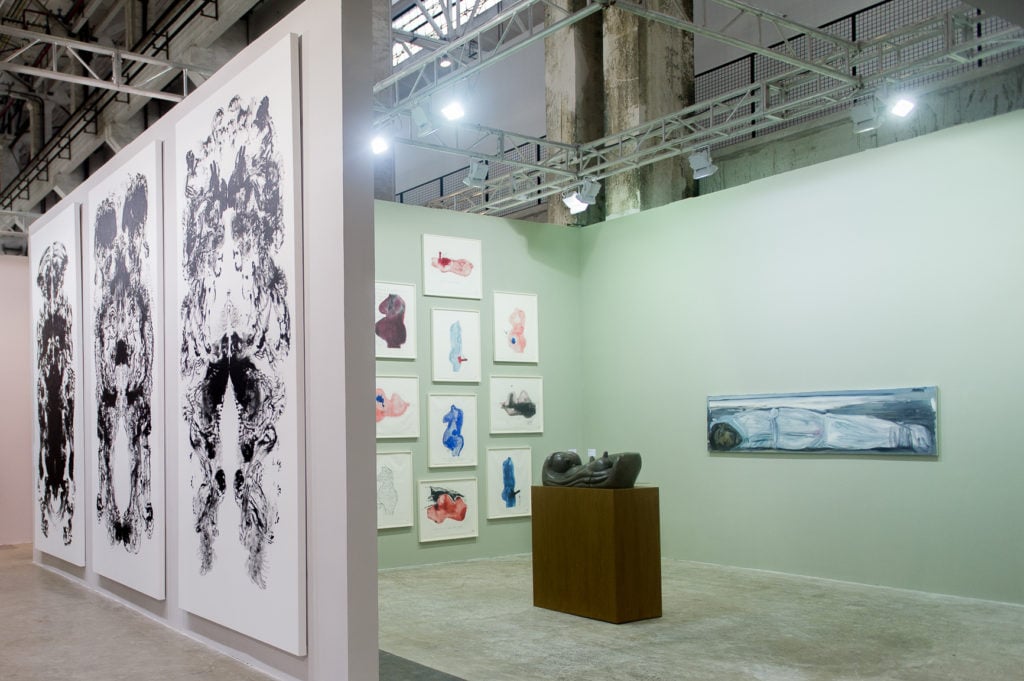
Hauser & Wirth. Courtesy of Zhongming.
Esther Schipper also brought artists who had done well in Hong Kong such as the large colorful sculptures of Angela Bullock, Liam Gillick and Philippe Parreno, along with some new ones that they were taking a chance on like Ryan Gander who had done an installation along one wall that involved painting two canvases, along with the wall space around them, with sparse playful brush strokes. They also brought spider-web works by Tomas Saraceno, who will be in the upcoming Shanghai Biennale. With works ranging from €70,000-90,000, Schipper sold roughly €200,000’s worth of works by Saraceno on the first day.
Senior director of Hauser & Wirth, Neil Wenman, said they brought “major paintings” by artists like Sterling Ruby and Mark Wallinger. Also very popular with the crowds, according to Wenman, was a gorgeous installation of prints, a joint project by Louise Bourgeois and Tracey Emin called “Do Not Abandon Me,” that featured poignant images of pregnant women, and men with erections.
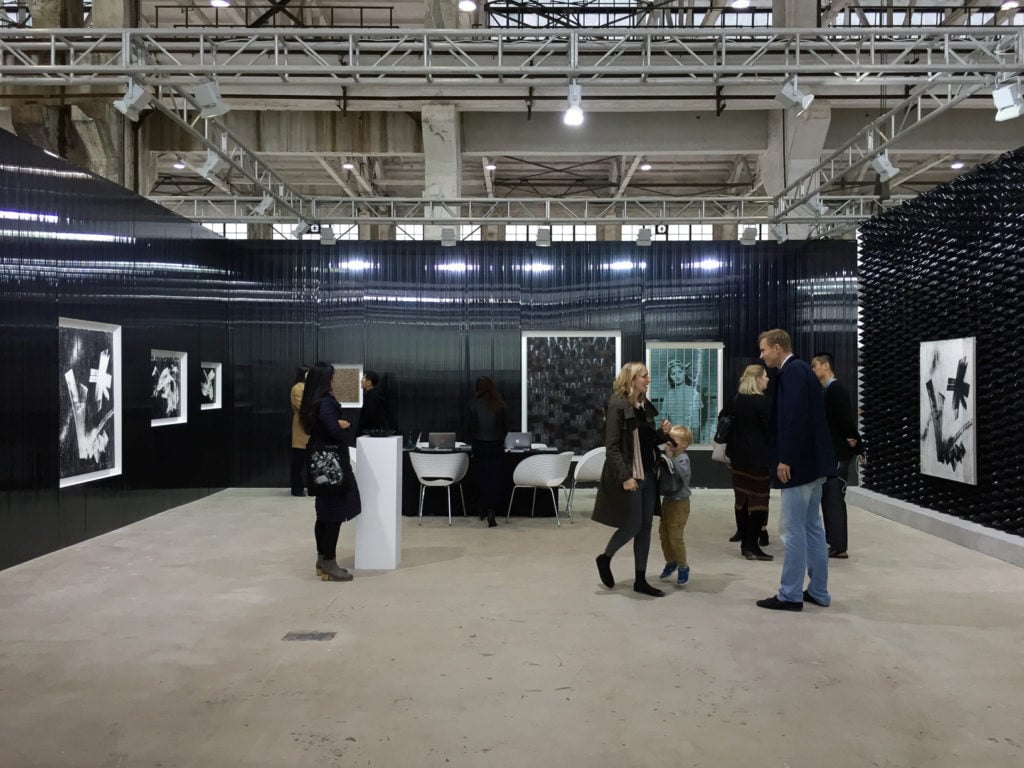
Galerie Perrotin. Courtesy of Zhongming.
Emanuel Perrotin, there for the first time, installed a dramatic solo booth of the work of Gregor Hildebrand, an artist who works with sound carrying materials such as old records and cassette tape. The walls of the booth were covered in audio cassette tape, which gave it a dramatic black sheen. Several works had sold including a large painting, and one work, Further, Further, composed of felt pads from a cassette.
While the increased international presence this year was a boon for most local dealers we spoke with who noted that it boosted their exposure to new collectors, and were proud to be part of a fair run by Tiehai, who’s an important and dynamic personality in the art world in China, for a few local dealers, it was a double-edged sword. One, who asked to remain anonymous, expressed concern that mainland Chinese artists might get sidestepped by collectors in the rush to learn more about their heavyweight Western counterparts.
The fair was an absolute pleasure to walk through, with a grand set of sweeping stairs at one end of the ample fair space, a former airplane hangar, connecting the two floors. There were projects interspersed throughout the fair—like a dazzling sound installation by Haroon Mirza at Lisson and a hip presentation by Ibid of a house-like structure modeled on a “nail house” that was painted green and hung with romantic paintings by Christopher Orr—that offered more immersive exhibition experiences and room to breathe.
Ibid director Magnus Edensvard said his experience at the fair was better than usual, and that was due to Tiehai, who was a “very thoughtful” director and worked closely with him to realize the project.
The West Bund Art & Design Fair kicks off Shanghai Art Week, which continues with Art021 and the Shanghai Biennale.